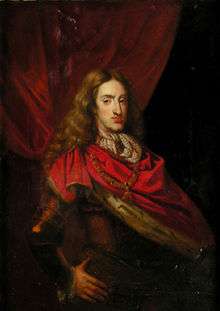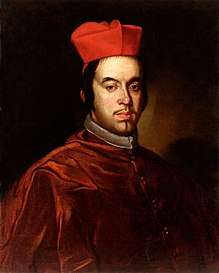Treaty of London (1700)
The Treaty of London (1700) or Second Partition Treaty was the second of two attempts by France, Great Britain [lower-alpha 4] and the United Provinces, or Dutch Republic, to impose a diplomatic solution to the issues that resulted in the 1701-1714 War of the Spanish Succession.
Long name:
| |
|---|---|
 Archduke Charles (1685-1740) aged 10 | |
| Context | Voiding of 1698 First Partition Treaty due to the death of Joseph Ferdinand in February 1699 |
| Signed | 25 March 1700 |
| Location | London |
| Parties | |
The Treaty of The Hague (1698), or First Partition Treaty, made Joseph Ferdinand heir to the Spanish throne but became redundant when he died of smallpox in February 1699. The Treaty of London replaced him with Archduke Charles, the younger son of Emperor Leopold I, but ultimately failed to prevent the outbreak of war in 1701.
Background

In 1665, Charles II became the last Habsburg King of Spain; he suffered from ill health most of his life and by 1698 it seemed likely he would die childless. Spain's financial and military power declined during the 17th century but it remained powerful and largely intact, with territories in Italy, the Spanish Netherlands, the Philippines and large areas of the Americas.[1] Since the closest heirs were from the ruling Austrian Habsburg and French Bourbon families, the succession was of great significance to the European balance of power and a matter of debate for many years.[lower-alpha 5]

William III of England saw the Partition Treaties as a way of building on the relationship established at Ryswick with Louis XIV to create a lasting peace.[2] Imposing a solution to such an important issue on Spain and Austria seemed unlikely even at the time, especially given the levels of mistrust between the signatories, which had been at war almost continuously since 1670.
The English negotiated both treaties without notifying the Parliament or William's own ministers[NB}. That was still common practice in France but was no longer the case in England; Lord Somers, one of the Whig Junto, which managed the English government for William, was generally hostile to the provisions of the First Partition Treaty about which he learned only shortly before its signature.[3]
Few British or Dutch politicians trusted Louis, an impression strengthened when the Marquis d'Harcourt was sent as envoy to Madrid in November 1698 to build Spanish support for a French candidate.[4] The Spanish were unwilling to allow their empire to be partitioned without consultation to suit the needs of foreign powers. On 14 November 1698, Charles published his will, making Joseph Ferdinand heir to an undivided Spanish Monarchy, thus ignoring the territorial adjustments specified in the First Partition Treaty.[5] When the six-year-old died of smallpox in February 1699, another solution was required.
Negotiations

The Spanish were split into pro-Austrian and pro-French factions, the latter led by Fernández de Portocarrero, Cardinal and Archbishop of Toledo. For much of Charles' reign, the government was controlled by the 'Austrians', headed by his mother, Mariana of Austria, until her 1696 death and then his second wife, Maria Anna of Neuberg after her death in 1696. Under their influence, Spain joined the anti-French coalition during the Nine Years' War, which proved to be disastrous. By 1696, France held most of Catalonia, with Spain declaring bankruptcy in 1692. It had previously done so nine times between 1557 and 1666, including 1647, 1652, 1661 and 1666. However, Maria Anna retained power with the help of spurious rumours of her pregnancy. However, Charles was forced to banish some of her German entourage.[6]
For various reasons, the Austrians were unpopular with most of the Spanish nobility. Charles himself resented their arrogance and made it clear to Harcourt that he would not agree to partition the empire.[7] Many genuinely believed that a French candidate was preferable; the wars of the last 50 years suggested France was a better ally than opponent, and its ability to impose a solution on Spain or to protect it was much greater than that of Austria.[8]
After the death of Joseph Ferdinand, the Marquess of Torcy, Louis' senior foreign policy advisor, quickly agreed the terms of a revised treaty, which William approved in June 1699. However, after Austria refused the territorial concessions, the Dutch also delayed their consent. It was not until 12 March 1700 that the treaty was finally signed in London, followed by in The Hague on 24th.[9]
Provisions

The main change from the First Treaty was to replace Joseph Ferdinand with Archduke Charles heir to the Spanish throne, retaining Spain, its overseas Empire and the Spanish Netherlands. France received Naples, Sicily and the Spanish province of Gipuzkoa as well as the Duchy of Milan, which it would exchange for the Duchy of Lorraine.[10] France would also transfer Naples and Sicily to Victor Amadeus, Duke of Savoy in exchange for the Counties of Nice and Savoy.[lower-alpha 6]
While Leopold now accepted the principle of dividing the Spanish Empire, he objected to France being granted Spanish possessions in Italy, particularly Milan, which was considered essential to the security of Austria's southern borders.[11] In addition, Lorraine was an imperial state occupied by France in 1670 and only returned in 1697, whose recently restored hereditary Duke of Lorraine was Leopold's nephew. Therefore, neither Leopold or Victor Amadeus had agreed the territorial exchanges required by the treaty, and Spain would not even accept the principle.[12]
Aftermath

When the Spanish learned of the terms of the treaty of London in mid-June, Charles amended his will in favour of Archduke Charles, again specifying an undivided monarchy. In September, he became ill once more, and by the 28th, he was no longer able to eat. His death seemed imminent, and on 2 October, Portocarrero persuaded him to alter his will in favour of Louis XIV's grandson, Philip of Anjou.[13] Charles ordered all previous versions of his will destroyed, and when he finally died in November 1700, Philip was offered the throne.
When Louis received the formal Spanish offer to Philip on 9 November, one option was to insist on the Treaty of London. That made Archduke Charles King of Spain, but if Leopold continued to refuse the territorial concessions, France could call on Britain and the Dutch Republic to enforce the treaty. However, Foreign Minister Torcy reported that Britain and the Dutch Republlic wanted peace and would not fight and that the anti-French mood of the Austrian court meant war either way.[14] On 16 November 1700, Philip of Anjou was proclaimed King of Spain.
The two Partition Treaties failed to prevent the outbreak of war in 1701 although that was arguably the result of miscalculations by Louis. Their weak point was enforcement. As William noted when asked to put pressure on Leopold, it made little sense 'to go to war at present for a treaty I have only made to prevent war'.[15]
However, they demonstrated that imposing solutions by secret negotiations between monarchs without consultation was out of date. The reaction in England when Parliament was informed of the Treaties in March 1700 was one of fury, partly because of the terms, which were seen as actively damaging to English commercial interests, but also their approval without Parliament's knowledge. The Tory majority attempted to impeach those responsible, including Somers. While unsuccessful, the process embittered relations between the two parties and had a profound impact on British politics over the next two decades.[16]
See also
- Treaty of Den Haag (1698), the First Partition Treaty
- List of treaties
Footnotes
- Until 1707, England and Scotland were separate countries under one monarch, but treaties were signed by the King of Great Britain.
- Full original title The treaty betwixt the Most Christian King (ie France), the King of Great Britain, and the States General of the United Provinces for settling the succession of the crown of Spain and the dominions thereunto belonging in case his Catholick Majesty (Charles II of Spain) die without issue.
- As above; the Union Jack or King's Colour is used here for ease of convenience.
- Until 1707, England and Scotland were separate countries but Treaties were signed by the King of Great Britain.
- For example, it was referenced in the 1670 Secret Treaty of Dover between England and France and the 1689 Grand Alliance.
- These primarily consisted of the transalpine territories of the Duchy of Savoy, which became part of France in 1860.
References
- Storrs, Christopher (2006). The Resilience of the Spanish Monarchy 1665-1700. OUP Oxford. pp. 6–7. ISBN 0199246378.
- Rommelse, Gijs (ed), Onnenkirk, David (ed) (2011). Ideology and Foreign Policy in Early Modern Europe (1650–1750). Routledge. p. 303. ISBN 978-1409419136.CS1 maint: extra text: authors list (link)
- Sachse, William Lewis (1986). Lord Somers: A political portrait. Manchester University Press. pp. 147–148. ISBN 071900604X.
- Ward, William, Leathes, Stanley (1912). The Cambridge Modern History (2010 ed.). Nabu. p. 383. ISBN 1174382058.
- Ward, William, Leathes, Stanley (1912). The Cambridge Modern History (2010 ed.). Nabu. p. 385. ISBN 1174382058.
- Storrs, Christopher (2006). The Resilience of the Spanish Monarchy 1665-1700. OUP Oxford. p. 158. ISBN 0199246378.
- Onnekink, David (ed) Mijers, Esther (ed), Rule, John (2017). The Partition Treaties, 1698-1700; A European View in Redefining William III: The Impact of the King-Stadholder in International Context. Routledge. pp. 91–108. ISBN 978-1138257962.CS1 maint: multiple names: authors list (link) CS1 maint: extra text: authors list (link)
- Rommelse, Gijs (ed), Onnenkirk, David (ed) (2011). Ideology and Foreign Policy in Early Modern Europe (1650–1750). Routledge. p. 226. ISBN 978-1409419136.CS1 maint: extra text: authors list (link)
- Onnekink, David (ed) Mijers, Esther (ed), Rule, John (2017). The Partition Treaties, 1698-1700; A European View in Redefining William III: The Impact of the King-Stadholder in International Context. Routledge. pp. 91–108. ISBN 978-1138257962.CS1 maint: multiple names: authors list (link) CS1 maint: extra text: authors list (link)
- Mckay, Derek, Scott, HM (1983). The Rise of the Great Powers 1648 - 1815 (The Modern European State System). Routledge. p. 55. ISBN 0582485541.
- Rommelse, Gijs (2011). Ideology and Foreign Policy in Early Modern Europe (1650–1750). Routledge. p. 299. ISBN 978-1409419136.
- Onnekink, David (ed) Mijers, Esther (ed), Rule, John (2017). The Partition Treaties, 1698-1700; A European View in Redefining William III: The Impact of the King-Stadholder in International Context. Routledge. pp. 91–108. ISBN 978-1138257962.CS1 maint: multiple names: authors list (link) CS1 maint: extra text: authors list (link)
- Hargreaves- Mawdsley, HN (1979). Eighteenth-Century Spain 1700-1788: A Political, Diplomatic and Institutional History. Macmillan. pp. 15–16. ISBN 0333146123.
- Onnekink, David (ed) Mijers, Esther (ed), Rule, John (2017). The Partition Treaties, 1698-1700; A European View in Redefining William III: The Impact of the King-Stadholder in International Context. Routledge. pp. 91–108. ISBN 978-1138257962.CS1 maint: multiple names: authors list (link) CS1 maint: extra text: authors list (link)
- Rommelse, Gijs (2011). Ideology and Foreign Policy in Early Modern Europe (1650–1750). Routledge. p. 299. ISBN 978-1409419136.
- Gregg, Edward (1980). Queen Anne (Revised) (The English Monarchs Series) (2001 ed.). Yale University Press. p. 126. ISBN 0300090242.
Sources
- Hargreaves-Mawdsley, HN; Eighteenth-Century Spain 1700-1788: A Political, Diplomatic and Institutional History (Macmillan, 1979);
- Mckay, Derek and Scott, HM (ed); The Rise of the Great Powers 1648 - 1815 (The Modern European State System) (Routledge, 1983);
- Jones, JR; Britain and the World, 1649-1815 (Fontana Press, 1980);
- Rommelse, Gijs (ed), Onnenkirk, David (ed); Ideology and Foreign Policy in Early Modern Europe (1650–1750) (Routledge, 2011);
- Rule, John; The Partition Treaties, 1698-1700; A European View; in Redefining William III: The Impact of the King-Stadholder in International Context, Onnekink, David (ed) Mijers, Esther (ed); (Routledge, 2017)
- Rule, John and Trotter, Ben; A World of Paper: Louis XIV, Colbert de Torcy, and the Rise of the Information State; (McGill-Queen's University Press, 2014);
- Sachse, William Lewis; Lord Somers: A political portrait; (Manchester University Press, 1986);
- Storrs, Christopher; The Resilience of the Spanish Monarchy 1665-1700 (OUP Oxford, 2006);
- Ward, William, Leathes, Stanley (1912); The Cambridge Modern History (Nabu Press, 2010 ed.)